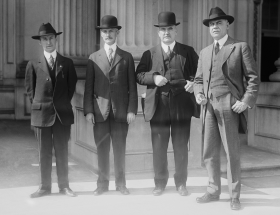Pages & Publicity
As with Looper and Mitchell, Pages occasionally emerged from their largely anonymous roles to occupy national attention. On March 1, 1954, Puerto Rican nationalists armed with handguns opened fire onto the House Floor from the southwest gallery. With Speaker Joe Martin of Massachusetts presiding, numerous Representatives, staff, and Pages were present for an upcoming vote. In the fusillade, five Representatives were struck—Alvin Bentley of Michigan, Ben Jensen of Iowa, Clifford Davis of Tennessee, George Fallon of Maryland, and Kenneth Roberts of Alabama. All five survived, although Bentley was critically wounded.
 /tiles/non-collection/6/6publicity_1954shooting_goodwin.xml
Image courtesy of Bill Goodwin, provided by the Office of the Historian, U.S. House of Representatives
This image, which appeared in newspapers across the country, shows House Page Bill Goodwin (left) carrying Representative Alvin Bentley of Michigan to an
ambulance on the East Front of the Capitol, following the 1954 House Chamber shooting. Pages Paul Kanjorski of Pennsylvania and Bill Emerson of Missouri (located in
the center of the image and the right, respectively), later served as U.S. Representatives.
/tiles/non-collection/6/6publicity_1954shooting_goodwin.xml
Image courtesy of Bill Goodwin, provided by the Office of the Historian, U.S. House of Representatives
This image, which appeared in newspapers across the country, shows House Page Bill Goodwin (left) carrying Representative Alvin Bentley of Michigan to an
ambulance on the East Front of the Capitol, following the 1954 House Chamber shooting. Pages Paul Kanjorski of Pennsylvania and Bill Emerson of Missouri (located in
the center of the image and the right, respectively), later served as U.S. Representatives.
Future Representatives
Bill Emerson of Missouri and
Paul Kanjorski of Pennsylvania, were among the Pages working on the House Floor that day.
Bill Goodwin recalled the experience: “To this day, I can still hear those bullets going
phht-dut,
phht-dut alongside of me, those two bullets that one landed above Bill Emerson, and one alongside Bill Emerson, which was just eight feet away from me, to my right. I can still hear those bullets hitting that mahogany wall.
Phht-dut, you know? What a sound. And the thing is, I saw that it was a gun, you know? I saw it right from the start of it. Saw the guy stand up.” Pages sprang into action when the shooting stopped. “I was aware that there were Members shot, so I got up immediately and went down to check on who was the most serious,” Kanjorski recalled. “I alerted my other fellow Pages that we needed stretchers, and we actually—funny enough … we sort of took over, ordering the stretchers and getting people put together.”
72 A group of a half dozen Pages helped to evacuate wounded Members to waiting ambulances on the East Front Plaza. In an iconic photograph that ran in hundreds of newspapers around the world, Kanjorski, Emerson, and Goodwin are seen descending the East Front steps, bearing a wounded Representative on a stretcher.
 /tiles/non-collection/6/6publicity_page_collier_kennedy_rogers_1919_lcH26130049.xml
Image courtesy of the Library of Congress
Doorkeeper Bert Kennedy and Clerk of the House William Tyler Page, pictured here in 1919, served as Pages during their youth and continued to work at the
Capitol throughout their lives. Featured left to right: Postmaster Frank Collier, Kennedy, Sergeant at Arms Joseph Rogers, and Page.
/tiles/non-collection/6/6publicity_page_collier_kennedy_rogers_1919_lcH26130049.xml
Image courtesy of the Library of Congress
Doorkeeper Bert Kennedy and Clerk of the House William Tyler Page, pictured here in 1919, served as Pages during their youth and continued to work at the
Capitol throughout their lives. Featured left to right: Postmaster Frank Collier, Kennedy, Sergeant at Arms Joseph Rogers, and Page.
Other House Pages went on to fame and success in their post-Page years. Among the many Page alumni who went on to illustrious careers were William B. Cushing, the Civil War naval hero; Bill Gates (1972), who founded Microsoft; and Benjamin Jealous (1989), a president of the National Association for the Advancement of Colored People. More than two dozen U.S. Representatives first served in the Capitol as congressional Pages. One of the earliest was
Richard W. Townshend, born in Prince George’s County on the outskirts of Washington, D.C. Townshend served as a Page in the 1850s before moving to Illinois, where he earned a law degree, became involved in Democratic politics, and eventually represented a district in that state in the U.S. House from 1877 to 1889.
73


